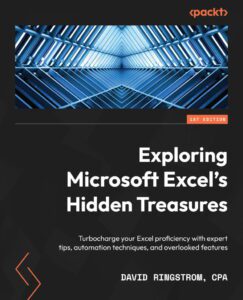David Ringstrom is the author of Exploring Microsoft Excel’s Hidden Treasures; we got the chance to sit down with him and find out more about his experience of writing with Packt.
Q: What are your specialist tech areas?
David: Microsoft Excel, QuickBooks Online, QuickBooks Desktop, Sage 50
Q: How did you become an author for Packt? Tell us about your journey. What was your motivation for writing this book?
David: When I was in my twenties I set three goals for myself: own my own business, teach, and write a book. Owning my own business came about quickly. Teaching took more time, but gradually teaching Excel webinars began overshadowing my spreadsheet consulting work. I wrote freelance articles on Excel for two years, and worked as a technical editor for 15 years to continually move myself closer to becoming an author. I had written one book on introductory accounting topics and two updates of a book on QuickBooks Online when Packt reached out to me to write a book on Quicken. During the meeting we realized there isn’t a market for books on Quicken. I expressed my desire to write a book on Excel, but as luck would have it, Packt had recently contracted with another author. However, that author had to withdraw from their project, and so the opportunity arose for me. It was a true pleasure to write this book and to work with Packt.
Q: What kind of research did you do, and how long did you spend researching before beginning the book?
David: I have worked as a spreadsheet consultant for 30 years and have taught over 2,000 webinars on Excel. I have spent an unhealthy amount of time watching others use Excel and this book arose from my observations over the decades of my career. I’ve been writing this book in my head for a couple of decades now, and I’m eternally grateful to Packt for bringing it to life. One topic that I did research is accessibility, which is a burgeoning interest of mine. It doesn’t take much effort to make a spreadsheet be accessible for those that are colorblind or need assistive technologies. Accommodations actually make spreadsheets easier for everyone to use because implementing accessibility incorporates discipline into spreadsheets that also improves spreadsheet integrity.
Q: Did you face any challenges during the writing process? How did you overcome them?
David: Two challenges that arose that I wrote a second book at the same time because my other publisher moved the publication date up on a book that I update once a year. On top of that I broke my arm in a mountain biking accident about a month and a half into writing this book. I solved the first challenge by planning my time well and switching between the two books. Regarding my arm, I was fortunate that I could always type. Early on I had to prop my laptop up on my legs in a particular fashion, but once positioned, I could type just fine.
Q: What’s your take on the technologies discussed in the book? Where do you see these technologies heading in the future?
David: Historically Microsoft was known for releasing a new version of Excel about every three years, which meant a long way between seeing new features in the software. Microsoft has opened the floodgates on new functionality with Microsoft 365. For instance, I cover the LAMBDA function in my book, which enables Excel users to create new worksheet functions in Excel by remixing existing functions and crafting custom calculations without using any programming code. I devote a whole chapter to Power Query, which is not a new functionality, but is another code-free solution that is not nearly as widely known as it should be. I foresee Microsoft making more and more code-free solutions available that empower the average user to work at a much higher level.
Q: Why should readers choose this book over others already on the market? How would you differentiate your book from its competition?
David: My initial idea for the subtitle of this book was “An exploration of Excel’s quirks and nuances.” I have a penchant for the odd stuff in Excel, as I find that’s what tends to frustrate everyone the most, no matter where they fall on the Excel continuum from beginner to expert.
Q: What are the key takeaways you want readers to come away with from the book?
David: A phrase I coined several years ago is “Either you work Excel, or it works you!” Many users use contorted workarounds or brute force techniques unnecessarily simply because they’re not aware of better ways to work in Excel. I chose several overlooked features in Excel based upon my years of consulting and teaching. I have a knack for knowing what the average person doesn’t know about Excel, but should, and so that’s what informs my webinars and informed this book. The other phrase I use a lot is “death by 1,000 cuts” in Excel, where many of us suffer minor slings and arrows in Excel simply because we’re unaware of features, options or techniques that can mitigate the low-level misery.
Q. What advice would you give to readers learning tech? Do you have any top tips?
David: If you’re trying to learn Microsoft Excel in particular, it’s best to have a goal in mind, meaning a specific problem or business situation that you want to solve or streamline. I’ll always remember the first spreadsheet that I put together to solve a business problem. I worked in commercial real estate in the late 1980s and much of the 1990s, and early on if a tenant’s monthly bill was incorrect, it fell to me to retype the invoice on a typewriter on multi-part carbon paper. There wasn’t room for typos. I configured a Lotus 1-2-3 spreadsheet so that I could review the bill on screen before printing, and I was hooked from there. Also, don’t expect technology to make sense the first time that you encounter it. The first time I saw Lotus 1-2-3 was a couple years earlier, and I didn’t know that it was necessary to hit the slash key to make the menu appear. I’ll always remember saying “Well, this is a stupid program, you can’t do anything with it!” I feel like l sealed my fate that day, but I wouldn’t have it any other way.
Q. Do you have a blog that readers can follow?
David: I post techniques occasionally on Twitter and LinkedIn.
Q. Can you share any blogs, websites and forums to help readers gain a holistic view of the tech they are learning?
David: Mike Tholfsen works for Microsoft and posts tips on various Microsoft products, including Excel, on TikTok, Twitter, and Instagram. He gets straight to the point and packs a lot of learning into 30 to 60 second segments. Bill Jelen, known as Mr. Excel, has published 2,500 YouTube videos, and counting.
Q. How would you describe your author journey with Packt? Would you recommend Packt to aspiring authors?
David: I am grateful that Packt reached out to me to inquire about writing a book on Quicken, which in the end started the conversation and ultimately led to me getting to write the book that I’ve always wanted to write. I am grateful to Packt for keeping me in mind even though they did not have an immediate spot in their line-up for me. Things shifted, and a space opened up. I strongly recommend Packt for both aspiring and seasoned authors. The time between when I finished my book and when it hit stores felt lightning quick, and Packt’s support was fantastic during the entire writing process. I greatly appreciated Packt’s indulgence of my peripatetic writing style as I both followed my muse through the manuscript and then completely rewrote about half of the book during the editing stage. I am particularly grateful for the additional pages I was granted for my book, as I truly expected to leave much of the book on the cutting room floor, so to speak, but I wanted to at least initially cover topics to the depth that I felt warranted.
Q. Do you belong to any tech community groups?
David: I keep myself so busy that I just don’t have the bandwidth, partly because I have ADHD which keeps me drifting off to new things constantly.
Q. What are your favorite tech journals? How do you keep yourself up to date on tech?
David: I participate in the free Microsoft Insider program, which lets me beta test new features that are being considered for Excel. Back when I first started working with spreadsheets, I used to have stacks and stacks of books that I’d rifle through, but now anything I need to catch up on is a Google search away. Any time something in Excel slows you down, you’re probably just well-written search term away from a much better solution.
Q. How did you organize, plan, and prioritize your work and write the book?
David: I wrote a detailed outline for the book right before the Christmas holiday. It was a bit surreal, because later on I didn’t remember creating the outline, but it was exquisitely detailed, and served as an excellent road map. I did change the nature of a couple of chapters as I got into the book, but I mostly followed my outline. I have ADHD, so I followed my brain through the book, meaning I wrote the chapters in a random sequence that made sense to me as I went. Given that I was writing two books at once, I had to batch my writing time, and also make sure to dedicate portions of most days to write, while also keeping up as best I could with my normal work. Fortunately, a lot of my work these days involves teaching Excel online, so webinars were easy to work into my writing schedule.
Q. What is that one writing tip that you found most crucial and would like to share with aspiring authors?
David: Set an intention if you want to write a book. Exploring Excel’s Hidden Treasures is the book that has been in my head for many years. My path to becoming an author started with answering questions about spreadsheets on a now long-defunct platform called CompuServe. Lotus Corporation noticed me and asked me to become their forum moderator, which gave me a free CompuServe account. From there I was invited to write articles on spreadsheets for a company called The Cobb Group, who published paper journals for professionals each month. This was all back in the 1990s, before the rise of the Internet. Over the years one opportunity led to the next one, and at the end of this year I’ll have five books that have my name on them. Intention setting is a superpower, it keeps you moving step-by-step toward your goals, even though you often won’t feel the progress in the moment.
You can find David‘s book on Amazon by following this link : Please click here









